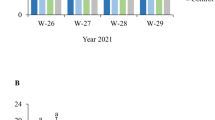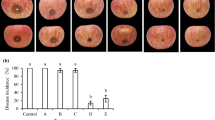Abstract
The yeast Pichia anomala strain K was selected in Belgium from the apple surface for its antagonistic activity against post-harvest diseases of apples. The efficacy of this strain against P. expansum was evaluated in the laboratory in three scenarios designed to mimic practical conditions, with different periods of incubation between biological treatment, wounding of fruit surface, and pathogen inoculation. Higher protection levels and higher final yeast densities were obtained when the applied initial concentration was 1 × 108 cfu ml−1 than when it was only 1 × 105 cfu ml−1. The protection level correlated positively with the yeast density determined in wounds and was influenced by apple surface wetness. In orchard trials spanning two successive years, biological treatment against P. expansum, based on a powder of P. anomala strain K (1 × 107 cfu ml−1), β-1,3-glucans (YGT 2 g l−1), and CaCl2.2H20 (20 g l−1), was applied to apples pre- or post-harvest under practical conditions and its effect compared with standard chemical treatments. The first year, the highest reduction (95.2%) against blue decay was obtained by means of four successive fungicide treatments and the next-highest level (87.6%) with pre-harvest high-volume spraying of the three-component mixture 12 days before harvest. The second year, the best results were obtained with post-harvest Sumico (carbendazim 25% and diethofencarb 25%) treatment and post-harvest biological treatment, both by dipping the apples, 88.3 and 56.3% respectively. A density threshold of 1 × 104 cfu cm−2 of strain K on the apple surface seemed to be required just after harvest for high protective activity, whatever the method and time of application. In the case of pre-harvest biological treatments, variations in meteorological conditions between the 2 years may have considerably affected strain K population density and its efficacies.




Similar content being viewed by others
References
Benbow, J. M., & Sugar, D. (1999). Fruit surface colonisation and biological control of postharvest diseases of pear by preharvest yeast applications. Plant Disease, 83, 839–844.
Chand-Goyal, T., & Spotts, R. A. (1996). Enumeration of bacterial and yeast colonists of apple fruits and identification of epiphytic yeasts on pear fruits in the Pacific Northwest United States. Microbiological Research, 151, 427–432.
De Clercq, D., Cognet, S., Pujol, M., Lepoivre, P., & Jijakli, M. H. (2003). Development of a SCAR marker and a semi-selective medium for specific quantification of Pichia anomala strain K on apple fruit surfaces. Postharvest Biology and Technology, 29, 237–247.
Droby, S., Wisniewski, M. E., Cohen, L., Weiss, B., Touitou, D., Eliam, Y., et al. (1997). Influence of CaCl2 on Penicillium digitatum, grapefruit peel tissue, and biocontrol activity of Pichia guillermondii. Phytopathology, 87, 310–315.
Elad, Y., & Kirshner, B. (1992). Establishment of active Trichoderma population in the phylloplane and its effect on grey mould (Botrytis cinerea). Phytoparasitica, 20, 137S–141S.
Guetsky, R., Shtienberg, D., Elad, Y., & Dinoor, A. (2001). Combining biocontrol agents to reduce the variability of biological control. Phytopathology, 91, 621–627.
Ippolito, A., & Nigro, F. (2000). Impact of preharvest application of biological control agents on postharvest diseases of fresh fruits and vegetables. Crop Protection, 19, 715–723.
Janisiewicz, W. J. (1988). Biological control of diseases of fruits. In K. G. Mukerji, & K. L. Garg (Eds.), Biocontrol of plant diseases (pp. 153–165). Boca Raton, FL: CRC.
Janisiewicz, W. J., & Korsten, L. (2002). Biological control of post-harvest diseases of fruits. Annual Review of Phytopathology, 40, 411–441.
Jijakli, M. H. (1996). Etude des propriétés antagonistes de deux souches de levures vis-à-vis de Botrytis cinerea Pres. sur pommes en conservation. Dissertation, Gembloux, Faculté Universitaire des Sciences Agronomiques, 173p.
Jijakli, M. H., Dickburt, C., De Clercq, D., & Lepoivre, P. (2002). Application de Pichia anomala souche K, 1,3-Glucanes et chlorure de calcium pour le contrôle des maladies de conservation des pommes en conditions proches de la pratique. In: 2ème Conférence Internationale sur les moyens alternatifs contre les organismes nuisibles aux végétaux. (pp. 436–445) Palais du Nouveau siècle, Lille-France.
Jijakli, M. H., Grevesse, C., & Lepoivre, P. (1999). Yeast species for biocontrol of apple postharvest disease: An encouraging case of study for practical use. In K. G. Mukerji, et al. (Ed.), Biotechnological approaches in biocontrol of plant pathogens (pp. 31–49). New York: Kluwer Academic.
Jijakli, M. H., & Lepoivre, P. (1998). Characterisation of an exo-β-1,3-glucanase produced by Pichia anomala strain K, antagonist of Botrytis cinerea on apples. Phytopathology, 88, 335–343.
Jijakli, M. H., Lepoivre, P., Tossut, P., & Thonard, P. (1993). Biological control of Botrytis cinerea and Penicillium sp. on post-harvest apples by two antagonistic yeasts. Mededelingen van de Faculteit landbouwwetenschappen - Rijksuniversiteit Gent, 58, 1349–1358.
Kovach, J., Petzoldt, R., & Harman, G. E. (2000). Use of honey bees and bumble bees to disseminate Trichoderma harzianum 1295–22 to strawberries for Botrytis control. Biological Control, 18, 235–242.
Lahlali, R. (2006). Etude et modélisation du comportement écologique de deux agents pathogènes de conservation des pommes P. expansum Link et B. cinerea Pers. et deux de levures Pichia anomala (souche K) et Candida oleophila (souche O) antagonistes vis-à-vis de ces pathogènes des pommes en conservation. Dissertation, Gembloux, Faculté Universitaire des Sciences Agronomiques, 155p.
Lakshminarayana, S., Sommer, N. F., Polito, V., & Fortlage, R. J. (1987). Development of resistance to infection by Botrytis cinerea and Penicillium expansum in wounds of mature apple fruit. Phytopathology, 77, 1674–1678.
Leibinger, W., Breuker, B., Hahn, M., & Mendgen, K. (1997). Control of postharvest pathogens and colonisation of the apple surface by antagonistic microorganisms in the field. Phytopathology, 87, 1103–1110.
Massart, S., De Clercq, D., Salmon, M., Dickburt, C., & Jijakli, M. H. (2005). Development of real-time PCR using Minor Groover Binding probe to monitor the biological control agent Candida oleophila (strain O). Journal of Microbiological Methods, 60, 73–82.
McLaughlin, R. J., Wisniewski, M. E., Wilson, C. L., & Chalutz, E. (1990). Effect of inoculation concentration and salt solutions on biological control of postharvest diseases of apple with Candida spp. Phytopathology, 80, 456–461.
Mercier, J., & Wilson, C. L. (1994). Colonisation of apple wounds by naturally occurring microflora and introduced Candida oleophila and their effect on infection by Botrytis cinerea during storage. Biological Control, 4, 138–144.
Smilanick, J. L. (1994). Strategies for the isolation and testing of biocontrol agents. In C. L. Wilson, & M. E. Wisniewski (Eds.), Biological control of postharvest diseases, theory and practice (pp. 25–42). Boca Raton, FL: CRC.
Spotts, R. A., & Cervantes, L. A. (1986). Populations, pathogenicity, and benomyl resistances of Botrytis spp, Penicillium spp, and Mucor piriformis in packinghouses. Plant Disease, 70, 106–108.
Spotts, R. A., Sanderson, P. G., Lennox, C. L., Sugar, D., & Cervantes, L. A. (1998). Wounding, wound healing and staining of mature pear fruit. Postharvest Biology and Technology, 13, 27–36.
Sutton, J. C., Li, D., Peng, G., Yu, H., Zhang, P., & Valdebenito-Sanhueza, R. M. (1997). Gliocladium roseum, a versatile adversary of Botrytis cinerea in crops. Plant Disease, 81, 316–328.
Teixidõ, N., Usall, J., & Viñas, I. (1999). Efficacy of preharvest and postharvest Candida sake biocontrol treatments to prevent blue mould on apples during cold storage. International Journal of Food Microbiology, 50, 203–210.
Tronsmo, A., & Dennis, C. (1977). The use of Trichoderma species to control strawberry fruit rots. Netherlands Journal of Plant Pathology, 83, 449–455.
Viñas, I., Vallverdu, N., Monallao, S., Usall, J., & Sanchis, V. (1993). Imazalil resistent Pencillium isolated from Spanich apples packinghouses. Mycopathologia, 123, 27–33.
Wilson, C. L., Wisniewski, M. E., Droby, S., & Chalutz, E. (1993). A selection strategy for microbial antagonists to control postharvest diseases of fruits and vegetables. Scientia Horticulturae, 53, 183–189.
Wisniewski, M., Droby, S., Chalutz, E., & Eliam, Y. (1995). Effects of Ca2+ and Mg2+ on Botrytis cinerea and Penicillium expansum in vitro and on the biocontrol activity of Candida oleophila. Plant Pathology, 44, 1016–1024.
Wisniewski, M. E., & Wilson, C. L. (1992). Biological control of postharvest diseases of fruits and vegetables: Recent advances. HortScience, 27, 94–98.
Acknowledgements
We thank the Royal Station in GORSEM for this collaboration and all those who provided technical assistance. This research was supported by DGA-DGTRE, the Walloon Region (Belgium), and the Academic Agency of Francophonia (AUF).
Author information
Authors and Affiliations
Corresponding author
Rights and permissions
About this article
Cite this article
Lahlali, R., Massart, S., De Clercq, D. et al. Assessment of Pichia anomala (strain K) efficacy against blue mould of apples when applied pre- or post-harvest under laboratory conditions and in orchard trials. Eur J Plant Pathol 123, 37–45 (2009). https://doi.org/10.1007/s10658-008-9337-7
Received:
Accepted:
Published:
Issue Date:
DOI: https://doi.org/10.1007/s10658-008-9337-7




